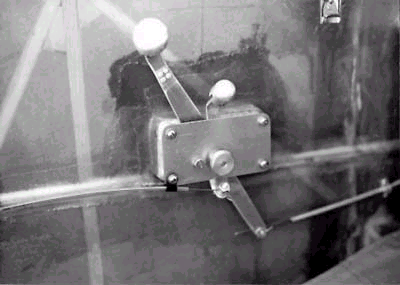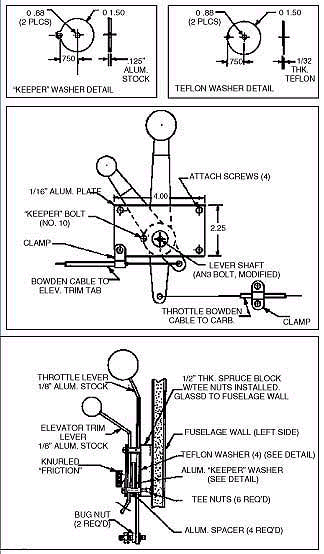A Precision Quadrant Control You Can Build
By Neil Bingham (originally published in EAA Sport Aviation, April 1994)
Sitting in the "office" of a P-51 once, I concluded that I would have a throttle lever that worked as smoothly some day. No doubt I could not even afford the gas to fly it, let alone fly the P-51, but I figured I could build a throttle control that felt as good. I decided I could custom build my own and make it look like it belonged in my little KR "office."
What is depicted in the accompanying drawing is basically what I built. It is inexpensive, rugged and smooth. But there are a few secrets.
The secret to the smoothness is in the 1/32" thick Teflon™ washers between all the parts. With Teflon’s™ natural slickness, it makes for a fine feel.
Another secret is keeping the motion of the other control(s) from affecting the throttle setting and vice versa, by the use of the aluminum "keeper" washer with its offset "keeper" bolt.
You can prevent throttle creep with a knurled "friction" knob. It can be tightened or loosened to give you what you want.
Easy disassembly is facilitated by the use of hardware store variety Tee Nuts, floxed into counterbored holes at the rear of the 1/2" thick spruce block.
To provide rigidity, flox and glass the spruce block to the fuselage wall. Incidentally, my fuselage wall and floor are "sandwich" all the way from the firewall to the rear of the baggage compartment. That is, the trusses have mahogany plywood on the outside, urethane foam between and glass cloth on the inside. The spruce block is directly over one of the diagonal truss members and it is very rigid.
The quadrant is versatile in that a mixture control lever can be fitted by increasing the spacer length and installing another Teflon™ washer and another aluminum "keeper" washer.
To get the right throw lengths, i.e., throttle knob travel vs carburetor throttle valve lever travel, for instance, work out what you want carefully and adjust the lever lengths above and below the quadrant’s lever shaft centerline to give you what you need. In my case, I use a front firewall mounted jackshaft (12.5" long) from the left side of the firewall to just past the firewall centerline. The throttle lever Bowden cable comes past the left side of the fuel tank, through the firewall and attaches to an arm on the jackshaft. The linkage to the carburetor attaches to an arm at the other end of the jackshaft and goes straightforward to the right side of the carburetor, which is mounted on the centerline of the engine. I wound up with 58 degrees of travel in the throttle lever.
By making the length of the throttle lever above the lever shaft centerline greater than that below, I was able to get a nice long "throw" on the throttle knob. This helps de-sensitize the throttle action. Otherwise, a small motion of the throttle knob would make too much difference in the carburetor throttle valve setting and it would be too touchy.
Make and assemble all the parts before the spruce block is glassed to the fuselage wall to be sure you get the throttle in the proper place. Then get in the plane and try the quadrant in several positions. It won’t be long before you will know where it should be. Make sure you can pull your arm back far enough before hitting your elbow against the seat back to come to throttle idle position. At this point you may want to consider a simple foam and glass arm rest also attached to the fuselage wall.


